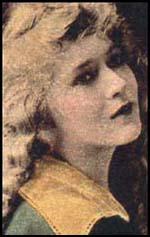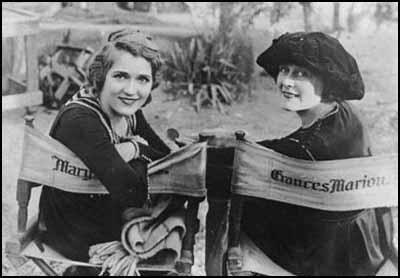Mary Pickford

Gladys Smith (Mary Pickford) was born in Toronto, Ontario, on 8th April, 1893. Her alcoholic father left his family soon after her birth and died of a cerebral hemorrhage in 1897.
A very pretty child, at the age of seven, she managed to get work with the Toronto's Princess Theatre. Eventually she joined a touring company. Later she said that she detested the colour crimson as it reminded her of the train seats smelling of coal dust on which she and her mother spent so much time travelling between towns.
Pickford moved to New York City and in 1907, with help from the producer, David Belasco, managed to get a couple of roles on Broadway. In 1909 Pickford, now aged sixteen, was discovered by D.W. Griffith, who offered to hire her on $5 a day. She refused, demanding $10. Griffith agreed and gave her the leading role in the picture The Little Teacher (1910). This established Pickford in Hollywood and she made a series of highly successful films including The Temptress (1911), A Child's Remorse (1912), The One She Loved (1912), In the Bishop's Carriage (1913), Caprice (1913), A Good Little Devil (1914) and Such a Little Queen (1914).
The film critic, David Thompson, has argued that Griffith therefore launched "the greatest star there has ever been". He added that Pickford "became the industry's chief focus and biggest asset... she played her heroines with idealism and spunk, with subtle suggestions of the nymphet... Mary's expressions were restrained, her gestures small and drawn-out, and therefore all the more expressive." D.W. Griffith said that "she never stopped listening and learning."
Pickford was able to demand high salaries for her films and it is estimated that she was earning $10,000 a week. According to Sam Goldwyn: "It took longer to make one of Mary's contracts than it did to make one of Mary's pictures." Other successful films made by Mary Pickford during this period included Broken Hearts (1915), The Foundling (1915), The Dawn of a Tomorrow (1915), Madame Butterfly (1915), The Eternal Grind (1916), Less Than the Dust (1916), The Poor Little Rich Girl (1917), A Little Princess (1917) and Stella Maris (1918). Her film, Johanna Enlists (1918), was an attempt to help the recruiting campaign for the First World War.
In 1919 Pickford joined with D.W. Griffith, Charlie Chaplin and her husband, Douglas Fairbanks, to form United Artists, a company that enabled the stars to distribute their films without studio interference. It is also argued that it was in response to a rumour that the film companies intended to put a ceiling on the star salaries. Films made by Pickford during this period included Pollyanna (1920), The Love Light (1921), Rosita (1923), Sparrows (1926) and My Best Girl (1927).

In 1929 made her first talkie, Coquette, a film where she won the Academy Award as best actress. Some critics claimed that she unfairly won the award and that it was really a "lifetime achievement award." However, her next film, The Taming of the Shrew (1929), with her husband Douglas Fairbanks, was a financial disaster. This was followed by two more unsuccessful films and so she decided to retire as an actress. She later recalled that "I never liked one of my pictures in its entirety."
Pickford and Charlie Chaplin bought out Douglas Fairbanks and D.W. Griffith and in 1935 sold United Artists for $12,000,000. Although she retired from the cinema but frequently appeared on radio. She also produced two movies, The Gay Desperado (1936) and Sleep, My Love (1948).
Mary Pickford died in Santa Monica, California, on 28th May, 1979.
